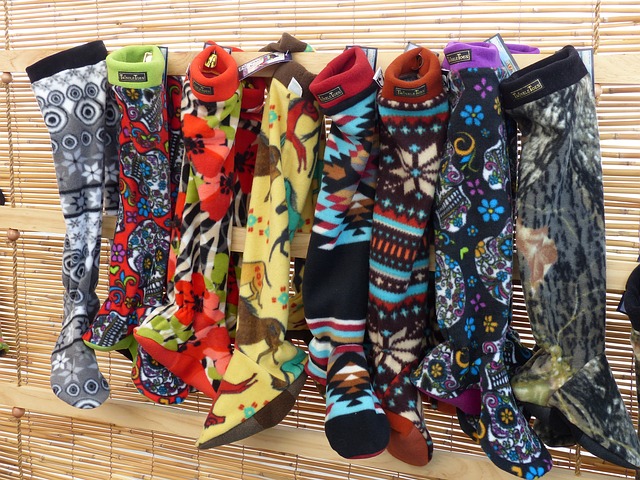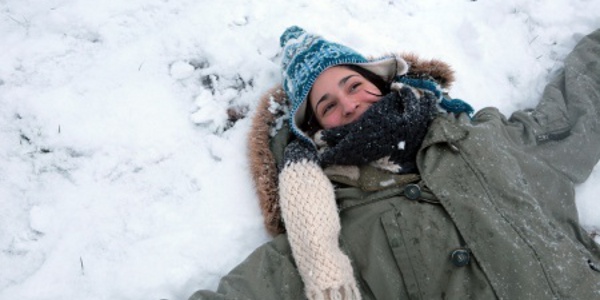
October 9, 2015, by Lucy
“There’s no such thing as bad weather, only unsuitable clothing”
Weather and wardrobe
The quote that I’ve used for the title of this post is popularly attributed to fellwalker and guidebook author and illustrator Alfred Wainwright, who spent much of his time outdoors, in the weather. Walking the remote Lakeland Fells it’s essential to be prepared for the weather, which can of course change rather rapidly!
A couple of weeks ago statistician James Hind of Nottingham Trent University (and formerly Robin Hood at the now closed Tales of Robin Hood tourist attraction) unveiled his ‘Stocking Forecast’ to the BBC. Hind’s formula uses wind speed and temperature data to determine the thickness of tights required on any particular day.
Whether or not we have dedicated summer and winter wardrobes, most of us adjust our clothing seasonally, and in accordance with the weather (particularly temperature and rainfall) we expect on a daily basis. Our morning decision of what to wear is of course also influenced by our planned activities, whether we’ll be spending the majority of our time outside, or in climate-controlled buildings.
The issuing of the ‘Stocking Forecast’ got me thinking about references to clothing in the accounts of extreme weather I’ve been collecting in the archives. Many of our weather narratives were written by people who spent much of their days working outside, in the weather. The practices of travel too were previously much more exposed to the elements, and of course it was definitely a case of ‘put on another jumper’ rather than switch on the central heating when the temperature dropped. Our authors then perhaps had much closer relationships with, and knowledge of, the weather than many of us do today. Clothing, as protection against the weather, was tremendously important. Insufficient clothing could lead to serious suffering or even death.
Clothing as comfort
Although in general references to clothing are quite rare in the materials we’ve been working on, a small number of accounts from the archives use clothing to describe the unexpected nature of the weather, whether it be mild weather during winter, or very cold wet weather in summer. Here are a couple of examples:
John Clifton’s day book for 1782 (Northamptonshire Record Office, ZA8745)
- Sunday April 28th – One of the most piercing cold days as ever came since the beginning of the world & great coats & cloaks are in danger of being quite threadbare by wearing them constantly
- Wednesday May 1st – Piercing cold. Instead of the lads & lasses being frolicksome & capering about according to the old May Day custom here is nothing but great coats & cloaks & dismal winter looking faces; this year; the Lord help us
- Saturday May 4th – a dismal winter day again. My self a prisoner – – great coats in May
- Wednesday May 29th – a most dismal wet day. I never saw such a dismal cold wet 29th May in my life before & the roads are so bad every where that the wood carters come home battle up to the armpits in sludge & muck & the horses to the top of their backs & the milk girls go to the pasture in high pattens [protective overshoes] & mens great coats.
- Tuesday June 4th – a piercing cold air & cloaks & great coats in full fashion the same as at Christmas
Robert Lowe’s diary for 1816 (Nottinghamshire Archives, DD/SK/217/20)
- 6 June – drank tea at Mrs Pigots… walked on the green put on my great coat being very cold indeed, N by E
Clothing relief
We have several references to the distribution of clothing during episodes of extreme weather. These fall into two groups; donations given to the poor by the parish or by individuals (coats, boots and blankets) as relief during hard winters; and the collection and distribution of clothing immediately following an extreme weather event – for example after the East Coast floods of 1953.
Poor relief
Journal and accounts of the Rev. S. E. Hopkinson of Etton of charitable distributions by Earl Fitzwilliam (Northamptonshire Record Office, F(M) Misc Vols/136)
1793
- Rec of L.F. Dec 24 1793 £20-0-0
- In hand from the preceding year £3
- Surplus of the last year £3
- Rec of L.F. Dec 28 1794 £20
- Bought of carpenter Smith of the Burrou of Southwark, the ostensible Patriot at that tie, a quantity of cloth wh was made up at Peterboro’ in vest-coats, inexpressibles &c for both sexes £13-10
- Rum, brandy, & gin for casual calls in sickness kept by a careful female in Etton 12s
- Carriage of goods from town 3s 6d
- An aged person of Maxey &c commended by Mr Bates 10s 6d
- This being a period of frost both as to severity & duration, I believe, unparalleled since the year 1739, I still further extended his Lordship’s good intentions to Etton & the vicinity in cloathing for the females cloaks & underlings £6 3s
- Occasional sick £2 1s 6d
1796
- Potatoes for the gardens £2
- Bland at different times in the present, as well as in the preceding year £2
- Hill? ditto £1
- The aged female with the bad leg of 50 years as before £1
- A short coat for the parish shepherd continually expos’d to the weather at all times in the year & 7 days in the week over an upon Lordship 18s
Disaster relief
Papers of the Cadbury family (Birmingham City Archives, MS 466/41/5/18)
- The Bournville Works Magazine
- Vol LI, No 3, March, 1953, Price 3d
- BOURNVILLE AND THE FLOODS
- ‘While the people at home were collecting clothes and money to relieve the distress of the victims, our Representative and Display men in the affected areas, their wives and some of our Demonstrators and the girls in our offices in nearby towns were rallying to render direct aid on the spot.’
- THE FIRST CONTRIBUTION – CLOTHING
- Appeal to employees for donations – splendid response
Weather dependent wardrobes today?
Geographer Russell Hitchings has studied the changing relationship that many people have with the outside world, many office workers now ‘insulated from the experience of seasonal change’ (2010). He has also explored international variation in how people in different places handle outdoor climate (2011).
Do you consult the forecast before deciding what to wear? Are you looking forward to the weather tuning colder so that you can dig out your winter coat? As usual we’d love to hear from you if you have any clothing and weather stories.
References
- Hitchings 2010 Seasonal climate change and the indoor city worker Transactions of the Institute of British Geographers 35(2): 282-298
- Hitchings 2011 Coping with the immediate experience of climate: regional variations and indoor trajectories Wiley Interdisciplinary Reviews: Climate Change 2(2): 170-184
No comments yet, fill out a comment to be the first


Leave a Reply